合并校对版
updated(V9.0)
1Z0-063 Oracle Database 12c: Advanced Administration
1. Which two are prerequisites for creating a backup-based duplicate database?
A. connecting to the target database and a recovery catalog to execute the duplicate command
B. creating a password file for an auxiliary instance
C. connecting to an auxiliary instance
D. matching the database identifier (DBID) of the source database and the duplicate database
E. creating an SPFILE for the target database
Answer:BC
string
integer 200
2. You are administering a multitenant container database (CDB) cdb1.
Examine the command and itsoutput:
SQL>show parameterfile
NAMETYPE VALUE
-----------------------------------------------------------------------
db_create_file_dest string
db_file_name_convert
db_files
You verify that sufficient disk space is available and that nofile currently exists in the
‘/u0l/app/oracle/oradata/cdb1/salesdb' location.
You plan to create a new pluggable database (PDB) by using the command:
SQL>CREATEPLUGGABLEDATABASE SALESPDB
ADMIN USER salesadm IDENTIFIED 3Y
password ROLES=(dba)
DEFAULT TABLESPACE sales
DATAFILE' /u01/app/oracle/oradata/cdb1/salesdb/sales01 .dbf’SIZE 250M AUTOEXTEND
ON
FILE_NAME_CONVERT=(‘/u01/app/oracle/oradata/cdb1/pdbseed/',
'/u01/app/oracle/oradata/cdb1/salesdb/')
STORAGE(MAXSIZE2G)
PATK_PREFIX='/u01/app/oracle/oradata/cdb1/SALESPDB';
Which statement is true?
A. SALESPDB is created and is in mount state.
B. PDB creation fails because the D3_file_name_convert parameter is not set in the CDB.
C. SALESPDB is created and is in read/write mode.
D. PDB creation fails because a default temporary tablespace is not defined for SALESPDB.
Answer:A
3. You are administering a multitenant container database (CDB) that contains multiple pluggable
databases (PDBs). You are connected to cdb$root as the sys user.
You execute the commands:
1 / 60
�
SQL> CREATE USER C##ADMIN IDENTIFIED BY orcll23;
SQL> CREATE ROLE C##CONNECT;
SQL> GRANT CREATE SESSION, CREATE TABLE, SELECT ANY TABLE TO
C##CONNECT;
SQL> GRANT C##CONNECT to C##ADMIN CONTAINER=ALL;
Which statement istrue about the c##connect role?
A. It is created only in cdb$root and cannot be granted to the c##admin user with the container=all clause.
B. It is granted to the c##admin user only in the CDB.
C. It is granted to the c##admin user in all PDBs and can be granted only to a local user in a PDB.
D. It is granted to the c##admin user in all PDBs and can be granted object and system privileges for a
PDB.
Answer:D
4. Examine the command:
$expdp SYSTEM FULL=YES DUMPFILE=dpump_dir1:fulll%U.dmp, dpump_dir2:full2% U.dmp,
dpump_dir3:full3%U.djnp FILESIZE=400M PARALLEL=3 JOB_NAME=expfull
Which statement is true about the execution of the command?
A. It fails because the log file parameter is not specified.
B. It fails because no absolutepath is specified for the log file and dump file.
C. It succeeds and exports the full database, simultaneously creating three copies of dump files at three
different locations.
D. It succeeds and exports the full database, simultaneously creating three dump files at three different
locations, but the total number of dump files can exceed three.
Answer: D
5. Which three statements are true about a job chain?
A. It can contain a nested chain of jobs.
B. It can be used to implement dependency-based scheduling.
C. It cannot invoke the same program or nested chain in multiple steps in the chain.
D. It cannot have more than one dependency.
E. It can be executed using event-based or time-based schedules.
Answer: A,B,E
Explanation:
Reference:http://docs.oracle.com/cd/B28359_01/server.111/b28310/scheduse009.htm#AD MIN12459
6. You are administering a database that supports data warehousing workload and Is running in
noarchivelog mode. You use RMAN to perform a level 0 backup on Sundays and level 1 Incremental
backups on all the other days of the week.
One of the data files is corrupted and the current online redo log file is lost because of a media failure.
You want to recover the data file.
Examine the steps involved in the recovery process:
1. Shut down the database instance.
2. Start up the database instance in nomount state.
3. Mount the database.
4. Take the data file offline.
2 / 60
�
5. Put the data file online.
6. Restore the control file.
7. Restore the database.
8. Restore the data file.
9. Open the database with the resetlog option.
10. Recover the database withthe noredo option.
11. Recover the data file with the noredo option.
Identify the required steps in the correct order.
A. 4, 8, 11, 5
B. 1, 3, 8, 11, 9
C. 1, 2, 6, 3, 7, 10, 9
D. 1, 3, 7, 10, 9
E. 1, 2, 6, 3, 8, 11, 9
Answer: C
7. Examine the command to create a pluggable database (PDB):
SQL> CREATE PLUGGABLE DATABASE pdb2 FROM pdb1
FILE_NAME-_CONVERT = ('/disk1/oracle/pdb1/', '/disk2/oracle/pdb2/’) PATH_PREFIX=
'/disk2/oracle/pdb2';
Which two statements are true?
A. The pluggable database pdb2 is created by cloning pdb1 and is in mount state.
B. Details about the metadata describing pdb2 are stored in an XML file in the '/disk2/oracle/pdb2/'
directory.
C. The tablespace specifications of pdb2 are the same as pdb1.
D. All database objects belonging to common users in PD3I are cloned in PD32.
E. pdb2 is created with its own private undo and temp tablespaces.
Answer: A,C
Explanation:
Reference:http://oracle-info.com/2013/07/27/12c-database-create-pdbs-plug-unplug/(see the table,
4throw)
8. You execute the RMAN commands:
RMAN> BACKUP VALIDATE DATABASE;
RMAN> RECOVER CORRUPTION LIST;
Which task is performed by these commands?
A. Corrupted blocks, if any, are repaired in the backup created.
B. Only those data files that have corrupted blocks are backed up.
C. Corrupted blocks in the data files are checked and repaired before performing the database backup.
D. The database is checked for physicallycorrupt blocks and any corrupted blocks are repaired.
Answer:A
9. In which three scenarios is media recovery required?
A. when a tablespace is accidentally dropped from a database
B. when archived redo log files are lost
C. when data files are lost
D. when one of the online redo log members is corrupted
3 / 60
�
E. when all control files are lost
Answer: A,C,E
Explanation:
Reference:http://docs.oracle.com/cd/A87860_01/doc/server.817/a76993/recoscen.htm
10. Examine the command to back up the ASM metadata:
ASMCMD>md_backup /backup/ASM_backup
In which three situations can you use the backup?
A. when one or more disks in an ASM disk group are lost
B. when the data file on an ASM disk group gets corrupted
C. when one of the disks in a disk group is accidentally unplugged
D. when one or more file directory paths are accidentally deleted from an ASM disk group
E. when all the ASM disk groups for the ASM instance are lost
Answer: B,C,D
11. Your multitenant container database (CDB) cdb1, which has no startup triggers and contains
multiple pluggable databases (PDBs), is started up by using the command:
SQL>STARTUP
Which two statements are true about the successful execution of the command?
A. All redo log files are opened.
B. The root, the seed, and all the PDBs are opened in read-write mode.
C. All the PDBs are opened in read-write mode.
D. All the PDBs are in closed state.
E. Only the root databaseis opened in read-write mode.
Answer: A,E
12. Your multitenant container database (CDB) contains multiple pluggable databases (PDBs).
You execute the command to create a common user:
SQL> CREATE USER c##a_admin
IDENTIFIED BY password
DEFAULT TABLESPACE users
QUOTA 100M ON users
TEMPORARY TABLESPACE temp;
Which statement is true about the execution of the command?
A. The common user is created in the CDB and all the PDBs, and uses the users and temp tablespaces of
the CDB to store schema objects.
B. The command succeeds only if all the PDBs have the users and temp tablespaces.
C. The command gives an error because the container=all clause is missing.
D. The command succeeds and sets the default permanent tablespace of a PDB as the default tablespace
for the c##a_admin user if the users tablespace does not exist in that PDB.
Answer:B
13. You want to consolidate databases for the CRM, ERP, and SCM applications by migrating them to
4 / 60
�
pluggable databases (PDBs). You have already created a test system to support the consolidation of
databases in a multitenant container database (CDB) that has multiple PDBs.
What is the easiest way to perform capacity planning for consolidation?
A. capturing the most resource-intensive SQL statements in a SQL Tuning Set on the production system
and using the SQL Performance Analyzer on the test system
B. capturing the workload on the production system and replaying the workload for one PDB at a time on
the test system
C. capturing the workload on the production system and using Consolidated Database Replay to replay
the workload of all production systems simultaneously for all PDBs
D. capturing the most resource-intensive SQL statements in a SQL Tuning Set on the production system
and using the SQL Tuning Advisor on the test system
Answer:C
14.A complete database backup to media is taken for your database every day.
Which three actions would you take to improve backup performance?
A. Set the backup_tape_io_slaves parameter to true.
B. Set the dbwr_io_slaves parameter to a nonzero value if synchronous I/O is in use.
C. Configure large pool if not already done.
D. Remove the rate parameter, if specified, in the allocate channel command.
E. Always use RMAN compression for tape backups rather than the compression provided by media
manager.
F. Always use synchronous I/O for the database.
Answer: B,C,D
Explanation:
Reference:http://docs.oracle.com/cd/B19306_01/backup.102/b14191/rcmtunin.htm
15. Evaluate these statements:
CREATE TABLE purchase_orders
(po_idNUMBER(4),
po_dateTIMESTAMP,
supplier_idNUM8ER(6),
po_totalNUMBER(8,2), CONSTRAINT order_pk PRIMARY KEY(po_id))
PARTITIONBYRANGE(po_date)
(PARTITIONQ1 VALUESLESSTHAN (TO_DATE('01-apr-2007','dd-mon-yyyy')),
PARTITIONQ2VALUESLESSTHAN(TO_DATE('01-jul-2007','dd-mon-yyyy')),
PARTITIONQ3VALUESLESSTHAN (TO~DATE('01-oct-2007','dd-non-yyyy')),
PARTITIONQ4VALUESLESSTHAN (TO_DATE('Ol-jan-2008','dd-non-yyyy' )));
CREATE TABLE purchase_order_items (po_id
NUMER(4)NOTNULL,
product_idNUMBER(6)NOTNULL,
unit_prlceNUMBER(8,2),
quantity NUMBER(8),
CONSTRAINTpo_items_f k
FOREIGNKEY(po_id)REFERENCESpurchase_orders(po_id) )
5 / 60
�
PARTITIONBYREFERENCE(po_items_fk);
Which two statements are true?
A. Partitions of purchase_order_items are assigned unique names based on a sequence.
B. The purchase_orders and purchase_order_items tables are created with four partitioneach.
C. purchase_order_items table partitions exist in the same tablespaces as the purchase_orders table
partitions.
D. The purckase_order_:teks table inherits the partitioning key by duplicating the key columns from the
parent table.
E. Partition maintenance operations on the purchase_order_items table require disabling the foreign key
constraint.
Answer: C,E
16. You are required to migrate your 11.2.0.3 database to an Oracle 12c database.
Examine the list of steps that might be used to accomplish this task:
1. Place all user-defined tablespaces in read-only mode on the source database.
2. Use the RMAN convert command to convert data files to the target platform's endian format, if required.
3. Perform a full transportable export on the source database with the parameters
VERSI0N=I2, TRANSPORTABLE=ALWAYS, and FULL=Y.
4. Transport the data files forall the user-defined tablespaces.
5. Transport the export dump file to the target database.
6. Perform an import on the target database by using the full, network_link, and transportable_datafiles
parameters.
7. Perform an import on the target database by using the full and transportable_datafiles parameters.
Identify the required steps in the correct order.
A. 1, 3, 5, 4, 2, and 6
B. 1, 2, 4, 6, 5, 3, and 7
C. 1, 2,4, and 7
D. 2, 4, 5, 6, and 7
Answer: A
17.Because of logical corruption of data in a table, you want to recover the table from an RMAN backup to
a specified point in time.
Examine the steps to recover this table from an RMAN backup:
1. Determine which backup contains the table that needs to be recovered.
2. Issue the recover table RMAN command with an auxiliary destination defined and the point in time
specified.
3. Import the Data Pump export dump file into the auxiliary instance.
4. Create a Data Pump export dump file that contains the recovered table on a target database.
Identify the required steps in the correct order.
A. 1, 4, 3
B. 1, 2
C. 1, 4, 3, 2
D. 1, 2, 4
Answer: B
Explanation:
6 / 60
�
https://docs.oracle.com/database/121/BRADV/rcmresind.htm#BRADV689
18. Your database is running in archivelog mode.
Examine the initialization parameters you plan to set for yourdatabase instance.
LOG_ARCHIVE_DEST_1 = 'LOCATION=/disk1/arch'
LOG_ARCHIVE_DEST_2 = 'L0CATI0N=/disk2/3rch'
LOG_ARCHIVE_DEST_3 = 'LOCATION=/disk3/arch'
L0G_ARCHIVE_DEST_4 = 'L0CATI0N=/disk4/3rch MANDATORY'
Identify the statement that correctly describes these settings.
A. An online redo log file is not allowed to be overwritten if the archived log file cannot be created in any of
the log_archive_dest_.n destinations.
B. Optional destinations cannot use the fast recovery area.
C. An online redo log file isnot allowed to be overwritten if the archived log file cannot be created in the
location specified for log_archive_dest_4.
D. These settings work only if log_archive_min_succeed_dest is set to a value of 4.
Answer:C
19. You want to create a guaranteed restore point for your database by executing the command:
SQL> CREATE RESTORE POINT dbrsp1 GUARANTEE FLASHBACK DATABASE;
Identify two prerequisites for the successful execution of this command.
A. The database must be running in archivelog mode.
B. Flashback Database must be enabled.
C. Fast Recovery Area must be enabled.
D. The recyclebin must be enabled for the database.
E. Undo retention guarantee must be enabled.
F. A database backup must be taken.
Answer:A,B
Explanation:
Reference:http://docs.oracle.com/cd/B19306_01/backup.102/b14192/rpfbdb002.htm
20. Which two statements are true about Resource Manager plans for individual pluggable databases
(PDB plans) in a multitenant container database (CDB)?
A. If no PDB plan is enabled for a pluggable database, then all sessions for that PDB are treated to an
equal degree of the resource share of that PDB.
B. In a PDB plan, subplans may be used with up to eight consumer groups.
C. If a PDB plan is enabled for a pluggable database, then resources are allocated to consumer groups
across all PDBs in the CDB.
D. If no PDB plan is enabled for a pluggable database, then the PDB share in the CDB plan is dynamically
calculated.
E. If a PDB plan is enabled for a pluggable database, then resources are allocated to consumer groups
based on the shares provided to the PDB in the CDB plan and the shares provided to the consumer
groups in the PDB plan.
Answer: A,E
7 / 60
�
Explanation:
A: Setting a PDB resource plan is optional. If not specified, all sessions within the PDB are treated
equally.
In a non-CDB database, workloads within a database are managed with resource plans.
In a PDB, workloads are also managed with resource plans, also called PDB resource plans.
The functionality is similar except for the following differences:
Non-CDB Database
Multi-level resource plans
Up to 32 consumer groups
Subplans
PDB Database
Single-level resource plans only
Up to 8 consumer groups
(Not B) No subplans
21. In a database supporting an OLTP workload, tables are frequently updated on both key and
non-keycolumns. Reports are also generated by joining multiple tables.
Which table organization or type would provide the best performance for this hybrid workload?
A. heap table with a primary key index
B. external table
C. hash clustered table
D. global temporary table
E. index clustered table
Answer:A
22. Your database supports a Decision Support System (DSS)workload that involves the execution of
complex queries. Currently, the database is running with peak workload. You want to analyze some of the
most resource-intensive statements cached in the library cache.
What must you run to receive recommendations on the efficient use of indexes and materialized views to
improve query performance?
A. SQL Performance Analyzer
B. SQL Access Advisor
C. SQL Tuning Advisor
D. Automatic Workload Repository (AWR) report
E. Automatic Database Diagnostic Monitor (ADDM)
Answer: B
Explanation:
Reference:http://docs.oracle.com/cd/B28359_01/server.111/b28275/tdppt_sqltune.htm#TDPPT160(4thpar
a)
23. Which two resources might be prioritized between competing pluggable databases (PDBs) when
creating a multitenant container database (COB) plan using Oracle Database Resource Manager?
A. maximum undo per consumer group
B. maximum idle time for a session in a PDB
C. parallel server limit
8 / 60
�
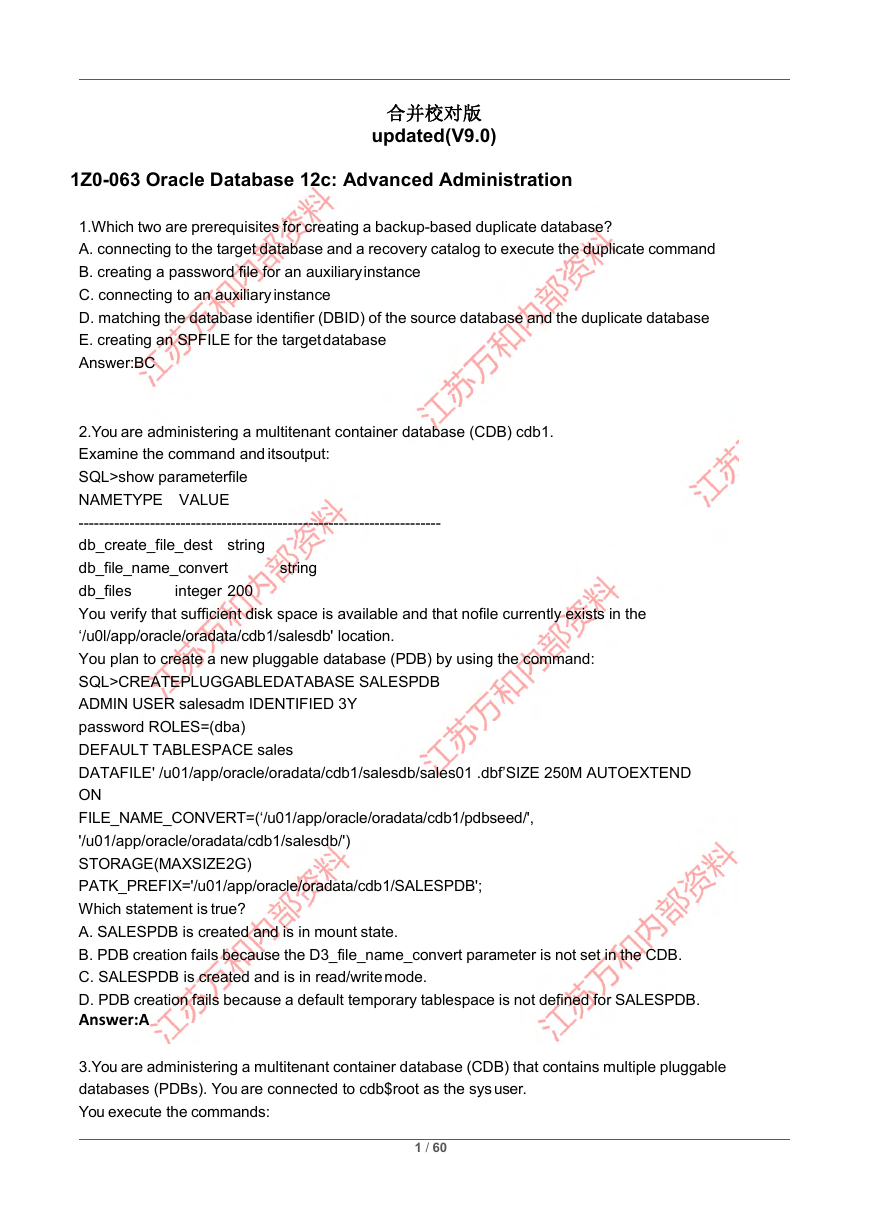
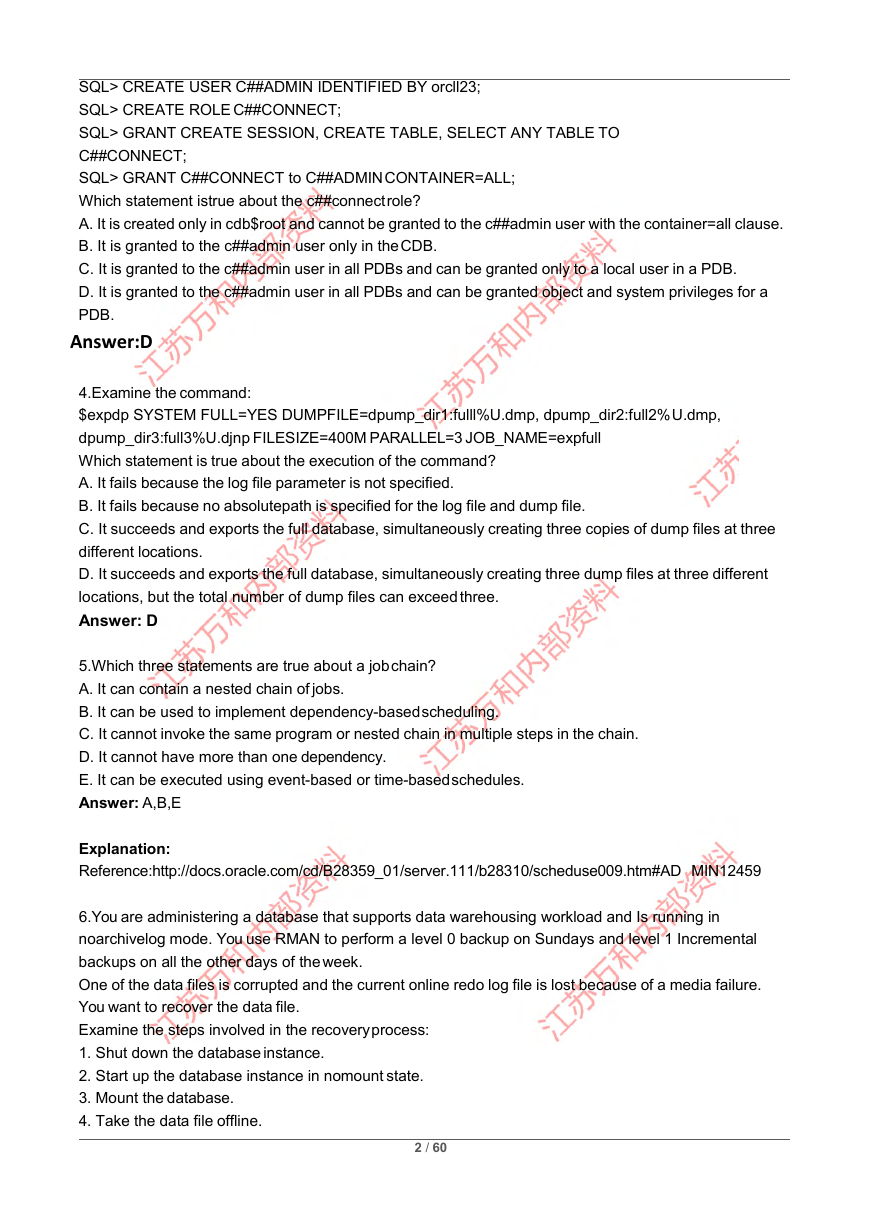
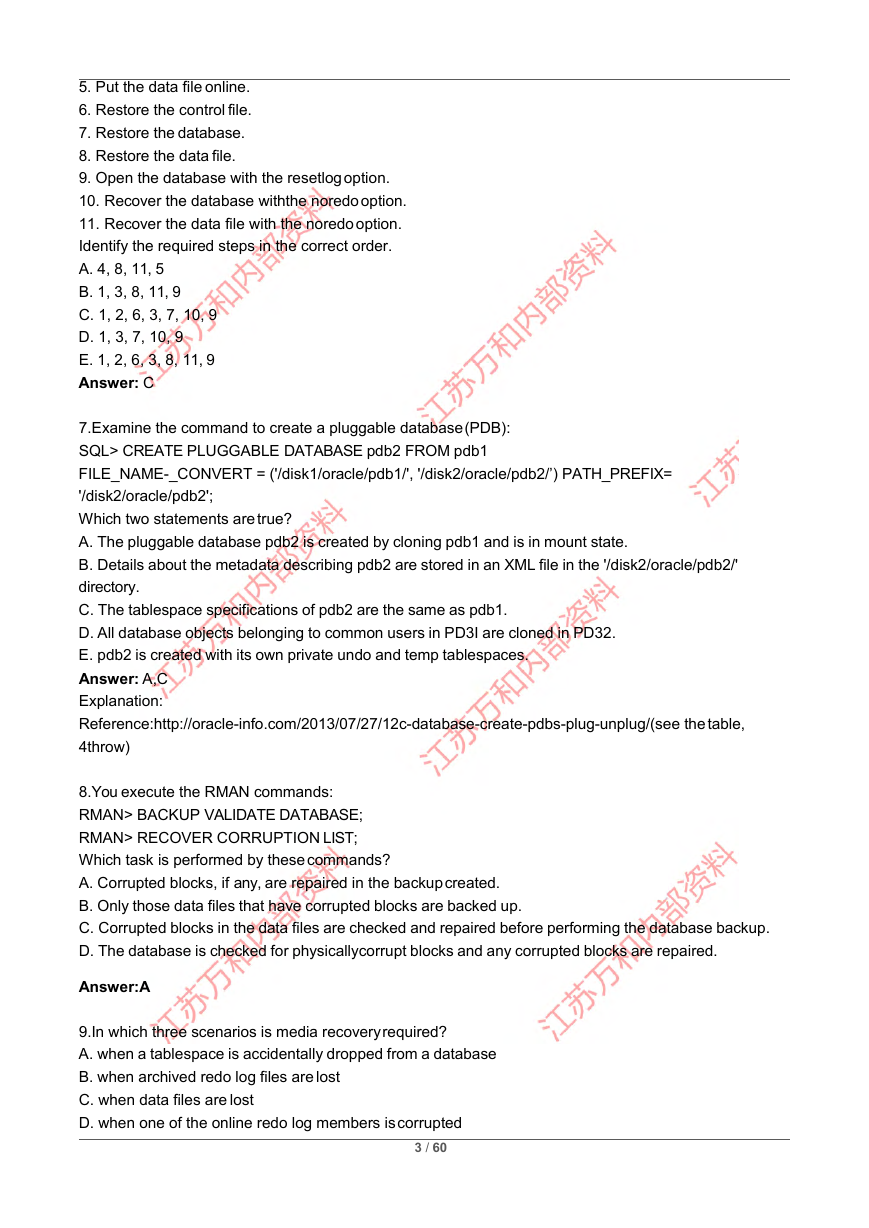
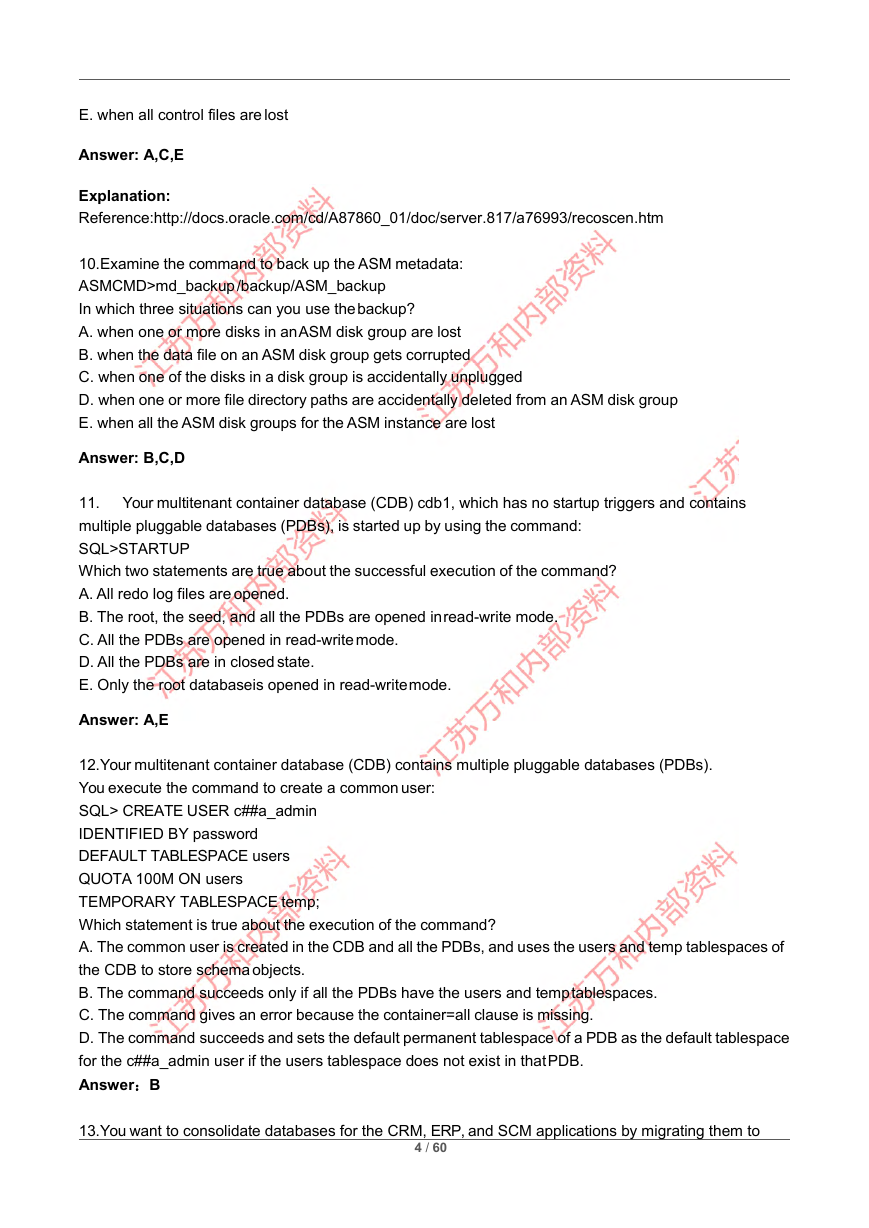


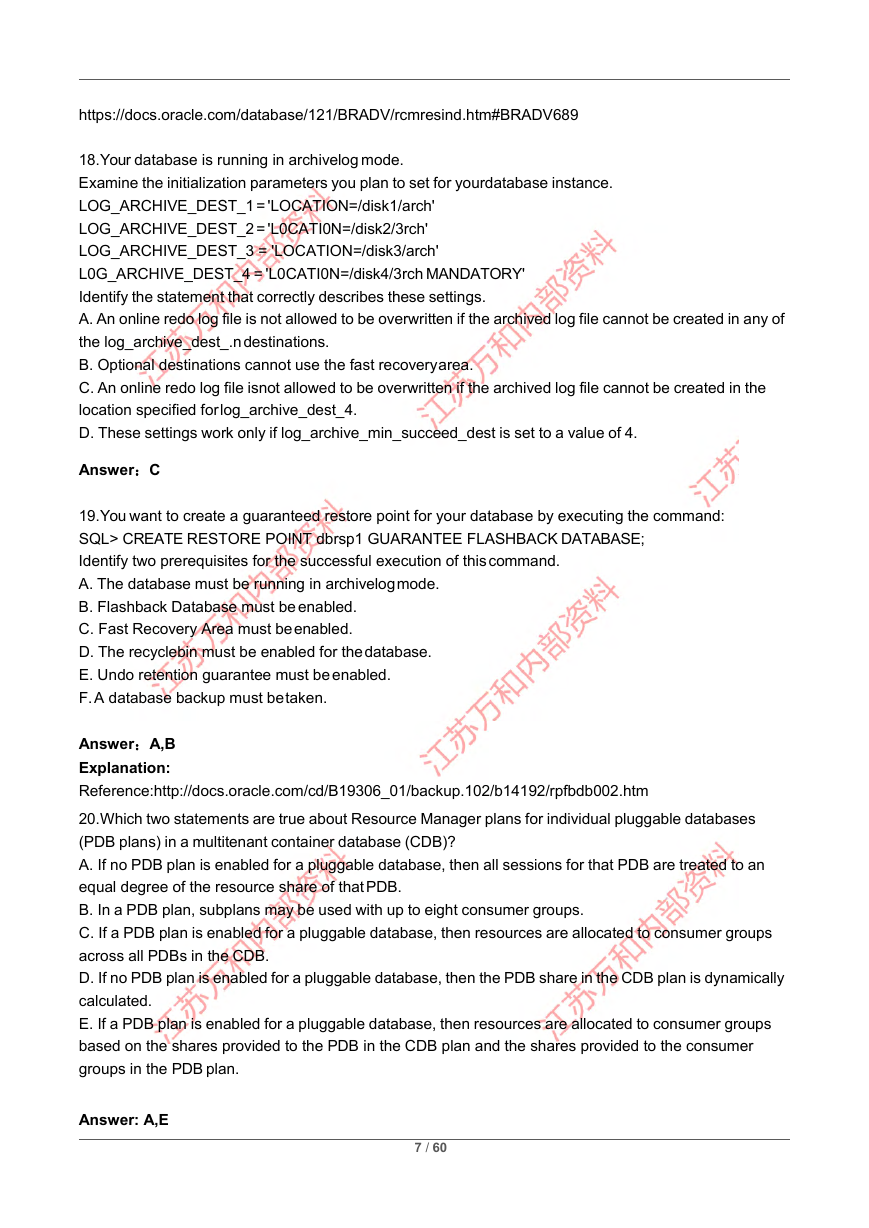









 2023年江西萍乡中考道德与法治真题及答案.doc
2023年江西萍乡中考道德与法治真题及答案.doc 2012年重庆南川中考生物真题及答案.doc
2012年重庆南川中考生物真题及答案.doc 2013年江西师范大学地理学综合及文艺理论基础考研真题.doc
2013年江西师范大学地理学综合及文艺理论基础考研真题.doc 2020年四川甘孜小升初语文真题及答案I卷.doc
2020年四川甘孜小升初语文真题及答案I卷.doc 2020年注册岩土工程师专业基础考试真题及答案.doc
2020年注册岩土工程师专业基础考试真题及答案.doc 2023-2024学年福建省厦门市九年级上学期数学月考试题及答案.doc
2023-2024学年福建省厦门市九年级上学期数学月考试题及答案.doc 2021-2022学年辽宁省沈阳市大东区九年级上学期语文期末试题及答案.doc
2021-2022学年辽宁省沈阳市大东区九年级上学期语文期末试题及答案.doc 2022-2023学年北京东城区初三第一学期物理期末试卷及答案.doc
2022-2023学年北京东城区初三第一学期物理期末试卷及答案.doc 2018上半年江西教师资格初中地理学科知识与教学能力真题及答案.doc
2018上半年江西教师资格初中地理学科知识与教学能力真题及答案.doc 2012年河北国家公务员申论考试真题及答案-省级.doc
2012年河北国家公务员申论考试真题及答案-省级.doc 2020-2021学年江苏省扬州市江都区邵樊片九年级上学期数学第一次质量检测试题及答案.doc
2020-2021学年江苏省扬州市江都区邵樊片九年级上学期数学第一次质量检测试题及答案.doc 2022下半年黑龙江教师资格证中学综合素质真题及答案.doc
2022下半年黑龙江教师资格证中学综合素质真题及答案.doc